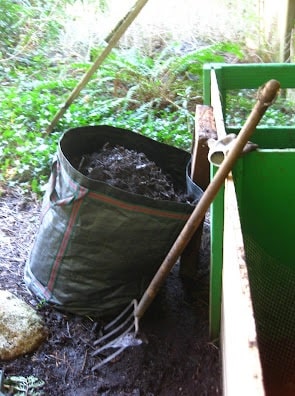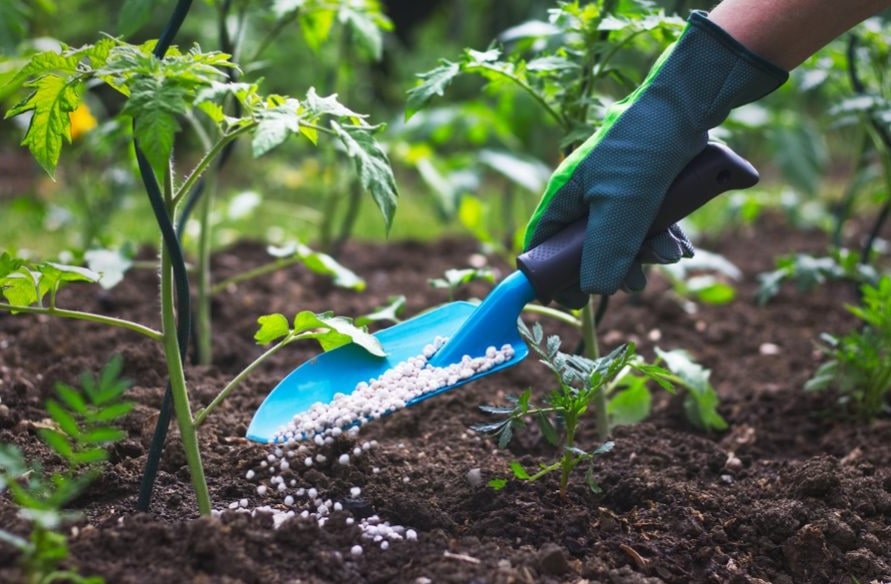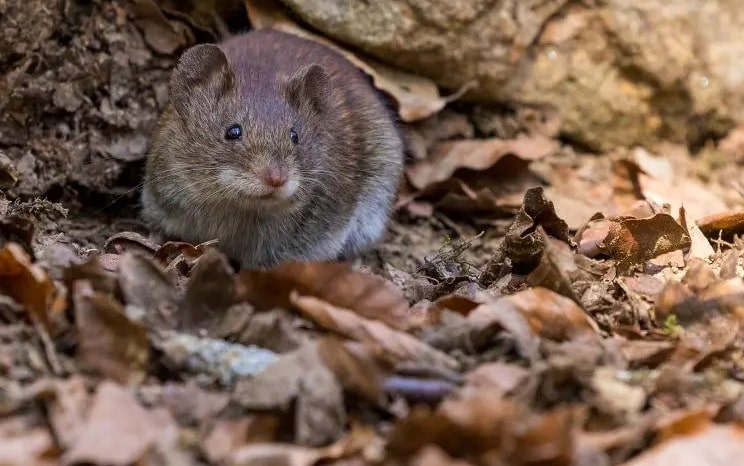You want to create a compost in your garden but wonder where a composter should be located?
Or you are not sure if the current compost location in your garden is really the right one?
Then you’ve come to the right place, because I’ll explain which location factors play a role for a composter
A compost should be in a semi-shaded location that has good foot and wheelbarrow access and aeration from at least two sides. In addition, a compost should be placed on loose and open ground with at least 0.5 meter distance from the neighbor. The compost site should ideally be located between the beds and the house but keep enough distance from the terrace or sandbox.
Where should a compost be located: all 7 location factors at a glance.
There are a total of 7 factors that play an important role in finding a location for your compost:
- Incidence of sunlight or light on the compost.
- Environment and air supply
- Subsoil for the compost
- Distance to the neighbor or property line
- Access road to the compost
- Distance from the bed/house
- Visibility to the compost
The interaction of these factors should determine where a compost should be placed.

In the following chapters, I will explain to you exactly what you should pay attention to in the individual factors so that you make the right choice when creating your compost.
Contents
- 1 1. sunlight or light incidence: the most important factor for the compost location.
- 2 2. create compost correctly: Environment and air supply
- 3 3. place the compost: Substrate
- 4 4 distance from the compost to the neighbor or the property line
- 5 5 access to the composting area
- 6 6 distance from the compost to the bed/house.
- 7 7 sight on the compost
- 8 Thermocomposter location
- 9 Author
1. sunlight or light incidence: the most important factor for the compost location.
Probably one of the most important factors for your compost location is the incidence of sunlight or light!
Can you place compost in the sun?
Not a good idea.
This is because it would cause the compost to dry out faster during dry spells in the summer or it could increase odors.
If your compost is currently in the sun and it has way too many ants, that’s a sign of dryness. Check here if you want to know what to do about it.
Should you put compost in the shade?
No, not a good idea either.
Because then it could be that on the one hand, too little rainwater falls on the compost, and on the other hand the compost is not warmed up enough or partly also can not dry up and therefore does not rot.
If your compost is too wet and stinks, then you can read here what you should do best.
So a compost location in partial shade is ideal!
In partial shade, the compost has the opportunity to always stay somewhat moist and warm, thus keeping the rot going.
Ideally, you should place your compost next to a tree, high shrubs, or a wall.
If this is not possible, you can plant tall flowers or vegetables, such as sunflowers or runner beans, next to the compost to provide adequate shade, especially in the summer.
2. create compost correctly: Environment and air supply
In addition to sunlight and light, the environment and air supply also play an important role in composting.
Namely, the environment of the compost is important in two ways:
Optimal aeration through the right compost location.
A compost should always be open on all sides so that fresh wind can pass through it from all sides.
This means you should never place your compost so that it is directly adjacent to a concrete wall, for example.
Otherwise, the compost has no chance to aerate properly and keep the rotting going.
So it is best to place the compost so that all sides are undeveloped.
In addition, already when buying the compost should be careful to choose the right model.
Good compost is well ventilated on all sides with many holes or ventilation gaps.
Classically, a metal composter (like this one) or a wooden plug-in composter (like this one) works very well.
Easy removal due to the right compost location
In addition to the airflow, of course, the removal plays an important role.
It is important that you can easily reach the compost from one side.
It is best to place the compost in such a way that you have plenty of room to shovel and work on at least one side, which is where you will remove the finished humus at the end.
So as long as one side is very easy to open and has enough space, all the other sides can be less accessible.
In addition to airflow, of course, removal plays an important role.
It is important that you can easily reach the compost from one side.
It is best to place the compost in such a way that you have plenty of room to shovel and work on at least one side, which is the side where you will remove the finished humus at the end.
So as long as one side is very easy to open and has plenty of room, all the other sides can be less accessible.
3. place the compost: Substrate
Third, when considering where to place a compost, you should pay attention to the proper soil conditions.
Overall, you must place your compost on a loose and open subsoil or soil.
This means, for example, a very loamy soil already in the upper layers is not ideal. A sandy soil, for example, or a mixture would be better.
But why should the soil under a compost be loose and open?
On the one hand, the rainwater or seepage water should have the opportunity to drain away, thus avoiding waterlogging.
If there is permanent waterlogging, e.g. because the soil under the compost absorbs seepage water only very slowly or with great difficulty, then rotting can occur in the compost. And you should always avoid that!
On the other hand, the rain worms and compost worms should be provided with the most ideal conditions possible to decompose the compost waste properly.
Again, it helps if loose soil prevails, so that the worms can move from the soil to the compost without any problems.
Place compost on concrete
If possible, compost should not be placed on concrete or slabs of stone, otherwise, there will no longer be direct contact with the soil.
On the one hand, this can result in less or no compost or earthworms being able to migrate from the soil into the compost, making the decomposition process more difficult.
On the other hand, it could lead to waterlogging because rainwater cannot drain directly into the soil.
It is true that rainworms or compost worms can be purchased and added to the compost, or the compost can be “inoculated” with a sufficient layer of garden soil, including worms, at the beginning. Nevertheless, it is not ideal for the compost climate and the decomposition process if it is placed on concrete.
What helps against voles in compost?
Compost should be placed on a loose, open soil surface to provide an ideal habitat for the worms so that rainwater can drain off in the best possible way.
However, depending on the location and environment of the plot, there is a risk that voles will also “get lost” in the compost.
There is a very simple solution to this problem that will not harm the compost or the voles:
When building the compost, simply place a close-meshed wire grid or even a special mole or vole grid (available here*) at the bottom of the compost to combat voles in the compost or keep them out from the start.
It is best to cut out the grid slightly larger than the actual ground plan of the compost so that the voles also have no chance at the sides.
What helps against voles in the compost
4 distance from the compost to the neighbor or the property line
Another location factor in compost construction is the property line or neighbors.
In general, compost is always very good at the property line or in the corner of a property, so it does not obstruct beautiful views.
However, you should always pay attention to your neighbor.
To avoid possible disputes, you should make sure that your compost is placed at a sufficient distance from the property line or the neighbors’ house or terrace.
5 access to the composting area
Besides the previous aspects, you should also pay attention to the following point when choosing the right location for your compost:
Make sure that the access road or driveway to the compost is easy and has enough space.
On the one hand, this is important for your daily or regular walk to the compost. Even in winter, you should have good access, perhaps via a path, to the compost.
On the other hand, a good path or access is also important, especially when you dispose of larger waste or remove the finished humus from the compost.
Then you will be glad if you can drive with a wheelbarrow* directly to the compost and have enough space to turn around.
So make sure you have good access to your compost all year round, both on foot and with the wheelbarrow*.
6 distance from the compost to the bed/house.
If you are wondering where a compost should be placed, then you should make sure that…
… the distance between compost and house or bed is not too big
… the distance between compost and e.g. terrace or sandbox is big enough.
On the one hand, it is of course helpful if you plan your paths as short as possible. That is if your regular walk from the house to the compost is relatively short.
It is also helpful if the compost is not too far away from your beds. This way you can dispose of garden waste more quickly and have a shorter walk when it comes to spreading the finished humus on the beds again.
On the other hand, it is advisable to position the compost as far away as possible from the patio, sandbox, or other play or recreational equipment in the garden.
Although compost should not stink if filled correctly, due to a lot of rain, compost can still always attract a few flies.
Therefore, my tip would be to place the compost a little away from it.
7 sight on the compost
Let’s move on to the last factor that should help you determine where your compost should be placed.
It is about the visibility of the compost.
As you can imagine, compost is often not a feast for the eyes, since the garden or some kitchen waste piles up there.
So it is advisable to place the compost a little out of sight of the patio.
As already mentioned, not only can odors from and possibly flies or birds cavort on the compost, but overall compost is not nice for many.
Therefore, it is best to place it behind or next to shrubs or trees so that the view is somewhat obscured.
Thermocomposter location
For a thermal composter (like this classic model from Neudorff*), slightly different rules apply than when creating a classic grid composter or plug-in composter made of wood or aluminum.
The most important rule when choosing a location for a thermal composter* is that it should always be in direct sunlight. This is the only way that the effect in the thermal composter can be developed and that the waste can be composted as quickly as possible due to heat or high temperatures.
All other location rules, such as the environment, the soil, the neighborhood and driveway, the distance from the house or bed, and the insight, should be observed with the thermal composter just as with a normal composter.








